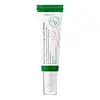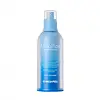What's inside
What's inside
 Key Ingredients
Key Ingredients

 Benefits
Benefits

 Concerns
Concerns

No concerns
 Ingredients Side-by-side
Ingredients Side-by-side

Water
Skin ConditioningGlycerin
HumectantNiacinamide
SmoothingSodium Hyaluronate
HumectantPropanediol
SolventErythritol
HumectantButylene Glycol
HumectantSqualane
EmollientOryza Sativa Bran Extract
Skin ConditioningCalendula Officinalis Flower Extract
MaskingCarica Papaya Fruit Extract
Skin ConditioningHippophae Rhamnoides Fruit Extract
Skin ConditioningMalpighia Glabra Fruit Extract
Skin ConditioningPolyglyceryl-10 Laurate
Skin ConditioningChlorphenesin
AntimicrobialArginine
MaskingEthylhexylglycerin
Skin ConditioningCarbomer
Emulsion StabilisingGlutathione
1,2-Hexanediol
Skin ConditioningHydroxypropyl Cyclodextrin
MaskingDisodium EDTA
Hydroxyethylcellulose
Emulsion StabilisingAllantoin
Skin ConditioningRosmarinus Officinalis Leaf Oil
MaskingWater, Glycerin, Niacinamide, Sodium Hyaluronate, Propanediol, Erythritol, Butylene Glycol, Squalane, Oryza Sativa Bran Extract, Calendula Officinalis Flower Extract, Carica Papaya Fruit Extract, Hippophae Rhamnoides Fruit Extract, Malpighia Glabra Fruit Extract, Polyglyceryl-10 Laurate, Chlorphenesin, Arginine, Ethylhexylglycerin, Carbomer, Glutathione, 1,2-Hexanediol, Hydroxypropyl Cyclodextrin, Disodium EDTA, Hydroxyethylcellulose, Allantoin, Rosmarinus Officinalis Leaf Oil
Water
Skin ConditioningGlycerin
HumectantMethylpropanediol
SolventHydrogenated Polyisobutene
EmollientMethyl Perfluoroisobutyl Ether
SolventCaprylic/Capric Triglyceride
MaskingMethyl Perfluorobutyl Ether
SolventCyclohexasiloxane
EmollientNiacinamide
SmoothingButylene Glycol Dicaprylate/Dicaprate
EmollientCetearyl Alcohol
EmollientGlyceryl Glucoside
HumectantCetearyl Olivate
Sodium Myristoyl Glutamate
CleansingArginine
MaskingElaeis Guineensis Kernel Oil
EmollientSorbitan Olivate
EmulsifyingDecyl Glucoside
CleansingHydroxyethyl Urea
HumectantBetaine
HumectantCetyl Palmitate
EmollientAmmonium Acryloyldimethyltaurate/Vp Copolymer
Sorbitan Palmitate
EmulsifyingMenthyl PCA
HumectantCarbomer
Emulsion StabilisingMyristic Acid
CleansingEthylhexylglycerin
Skin ConditioningHexylene Glycol
EmulsifyingDecylene Glycol
Skin ConditioningButylene Glycol
HumectantPropanediol
SolventPanthenol
Skin Conditioning1,2-Hexanediol
Skin ConditioningZingiber Officinale Root Extract
MaskingMelaleuca Alternifolia Leaf Extract
PerfumingSorbitan Oleate
EmulsifyingTotarol
AntioxidantSodium Hyaluronate Crosspolymer
HumectantAllantoin
Skin ConditioningXylitylglucoside
HumectantAdenosine
Skin ConditioningSodium Hyaluronate
HumectantHydrolyzed Glycosaminoglycans
HumectantGlyceryl Acrylate/Acrylic Acid Copolymer
HumectantAnhydroxylitol
HumectantDisodium EDTA
Xylitol
HumectantArgania Spinosa Kernel Oil
EmollientBenzyl Glycol
SolventGlucose
HumectantDecyl Alcohol
EmollientSalvia Sclarea Extract
AntiseborrhoeicLavandula Angustifolia Flower Extract
CleansingHydrolyzed Hyaluronic Acid
HumectantHyacinthus Orientalis Extract
Skin ConditioningChamomilla Recutita Extract
Skin ConditioningCentaurea Cyanus Flower Extract
AstringentBorago Officinalis Extract
EmollientPhlox Drummondii Seed Extract
Skin ConditioningHair Extract
Hydrogenated Lecithin
EmulsifyingBlue 1 Lake
Cosmetic ColorantFicus Carica Fruit Extract
HumectantCentella Asiatica Extract
CleansingSodium Guaiazulene Sulfonate
Ectoin
Skin ConditioningTocopherol
AntioxidantLeucine
Skin ConditioningHyaluronic Acid
HumectantPhenylalanine
MaskingIsoleucine
Skin ConditioningAspartic Acid
MaskingAlanine
MaskingCeramide NP
Skin ConditioningRaspberry Ketone
MaskingValine
MaskingTaurine
BufferingSerine
MaskingProline
Skin ConditioningOrnithine
Skin ConditioningMethionine
Skin ConditioningHistidine
HumectantGlycine
BufferingGlutamic Acid
HumectantCaprylyl Glycol
EmollientPalmitoyl Tetrapeptide-7
Skin ConditioningAcetyl Octapeptide-3
HumectantTripeptide-1
Skin ConditioningPalmitoyl Tripeptide-1
Skin ConditioningPalmitoyl Pentapeptide-4
Skin ConditioningCopper Tripeptide-1
Skin ConditioningAcetyl Hexapeptide-8
HumectantHexapeptide-9
Skin ConditioningNonapeptide-1
Skin ConditioningParfum
MaskingWater, Glycerin, Methylpropanediol, Hydrogenated Polyisobutene, Methyl Perfluoroisobutyl Ether, Caprylic/Capric Triglyceride, Methyl Perfluorobutyl Ether, Cyclohexasiloxane, Niacinamide, Butylene Glycol Dicaprylate/Dicaprate, Cetearyl Alcohol, Glyceryl Glucoside, Cetearyl Olivate, Sodium Myristoyl Glutamate, Arginine, Elaeis Guineensis Kernel Oil, Sorbitan Olivate, Decyl Glucoside, Hydroxyethyl Urea, Betaine, Cetyl Palmitate, Ammonium Acryloyldimethyltaurate/Vp Copolymer, Sorbitan Palmitate, Menthyl PCA, Carbomer, Myristic Acid, Ethylhexylglycerin, Hexylene Glycol, Decylene Glycol, Butylene Glycol, Propanediol, Panthenol, 1,2-Hexanediol, Zingiber Officinale Root Extract, Melaleuca Alternifolia Leaf Extract, Sorbitan Oleate, Totarol, Sodium Hyaluronate Crosspolymer, Allantoin, Xylitylglucoside, Adenosine, Sodium Hyaluronate, Hydrolyzed Glycosaminoglycans, Glyceryl Acrylate/Acrylic Acid Copolymer, Anhydroxylitol, Disodium EDTA, Xylitol, Argania Spinosa Kernel Oil, Benzyl Glycol, Glucose, Decyl Alcohol, Salvia Sclarea Extract, Lavandula Angustifolia Flower Extract, Hydrolyzed Hyaluronic Acid, Hyacinthus Orientalis Extract, Chamomilla Recutita Extract, Centaurea Cyanus Flower Extract, Borago Officinalis Extract, Phlox Drummondii Seed Extract, Hair Extract, Hydrogenated Lecithin, Blue 1 Lake, Ficus Carica Fruit Extract, Centella Asiatica Extract, Sodium Guaiazulene Sulfonate, Ectoin, Tocopherol, Leucine, Hyaluronic Acid, Phenylalanine, Isoleucine, Aspartic Acid, Alanine, Ceramide NP, Raspberry Ketone, Valine, Taurine, Serine, Proline, Ornithine, Methionine, Histidine, Glycine, Glutamic Acid, Caprylyl Glycol, Palmitoyl Tetrapeptide-7, Acetyl Octapeptide-3, Tripeptide-1, Palmitoyl Tripeptide-1, Palmitoyl Pentapeptide-4, Copper Tripeptide-1, Acetyl Hexapeptide-8, Hexapeptide-9, Nonapeptide-1, Parfum
 Reviews
Reviews

Ingredients Explained
These ingredients are found in both products.
Ingredients higher up in an ingredient list are typically present in a larger amount.
1,2-Hexanediol is a synthetic liquid and another multi-functional powerhouse.
It is a:
- Humectant, drawing moisture into the skin
- Emollient, helping to soften skin
- Solvent, dispersing and stabilizing formulas
- Preservative booster, enhancing the antimicrobial activity of other preservatives
Allantoin is a soothing ingredient known for its protective and moisturizingg properties. Because of this, it is often added to products with strong active ingredients.
Studies show higher concentrations of this ingredient can promote wound healing.
Though it can be derived from the comfrey plant, allantoin is produced synthetically for cosmetic products to ensure purity.
Learn more about AllantoinArginine is an amino acid that is important for human development. Your body uses is it to produce hair keratin and skin collagen.
As a cosmetic ingredient, Arginine has antioxidant properties and can also help repair damaged skin. This ingredient is derived either synthetically or from animals.
Arginine isn't fungal acne safe when used in the presence of other lipids (fats, fatty acids, oils, esters, etc). Oils and fats occur naturally within the skin, so take caution when using Arginine if you're prone to fungal acne.
Learn more about ArginineButylene Glycol (or BG) is used within cosmetic products for a few different reasons:
Overall, Butylene Glycol is a safe and well-rounded ingredient that works well with other ingredients.
Though this ingredient works well with most skin types, some people with sensitive skin may experience a reaction such as allergic rashes, closed comedones, or itchiness.
Learn more about Butylene GlycolCarbomer is a polymer of acrylic acid. Its main role is to create a gel consistency.
A high amount of carbomer can cause pilling or balling up of products. Don't worry, most products contain 1% or less of carbomer.
Disodium EDTA plays a role in making products more stable by aiding other preservatives.
It is a chelating agent, meaning it neutralizes metal ions that may be found in a product.
Disodium EDTA is a salt of edetic acid and is found to be safe in cosmetic ingredients.
Learn more about Disodium EDTAEthylhexylglycerin (we can't pronounce this either) is commonly used as a preservative and skin softener. It is derived from glyceryl.
You might see Ethylhexylglycerin often paired with other preservatives such as phenoxyethanol. Ethylhexylglycerin has been found to increase the effectiveness of these other preservatives.
Glycerin is already naturally found in your skin. It helps moisturize and protect your skin.
A study from 2016 found glycerin to be more effective as a humectant than AHAs and hyaluronic acid.
As a humectant, it helps the skin stay hydrated by pulling moisture to your skin. The low molecular weight of glycerin allows it to pull moisture into the deeper layers of your skin.
Hydrated skin improves your skin barrier; Your skin barrier helps protect against irritants and bacteria.
Glycerin has also been found to have antimicrobial and antiviral properties. Due to these properties, glycerin is often used in wound and burn treatments.
In cosmetics, glycerin is usually derived from plants such as soybean or palm. However, it can also be sourced from animals, such as tallow or animal fat.
This ingredient is organic, colorless, odorless, and non-toxic.
Glycerin is the name for this ingredient in American English. British English uses Glycerol/Glycerine.
Learn more about GlycerinNiacinamide is a multitasking form of vitamin B3 that strengthens the skin barrier, reduces pores and dark spots, regulates oil, and improves signs of aging.
And the best part? It's gentle and well-tolerated by most skin types, including sensitive and reactive skin.
You might have heard of "niacin flush", or the reddening of skin that causes itchiness. Niacinamide has not been found to cause this.
In very rare cases, some individuals may not be able to tolerate niacinamide at all or experience an allergic reaction to it.
If you are experiencing flaking, irritation, and dryness with this ingredient, be sure to double check all your products as this ingredient can be found in all categories of skincare.
When incorporating niacinamide into your routine, look out for concentration amounts. Typically, 5% niacinamide provides benefits such as fading dark spots. However, if you have sensitive skin, it is better to begin with a smaller concentration.
When you apply niacinamide to your skin, your body converts it into nicotinamide adenine dinucleotide (NAD). NAD is an essential coenzyme that is already found in your cells as "fuel" and powers countless biological processes.
In your skin, NAD helps repair cell damage, produce new healthy cells, support collagen production, strengthen the skin barrier, and fight environmental stressors (like UV and pollution).
Our natural NAD levels start to decline with age, leading to slower skin repair, visible aging, and a weaker skin barrier. By providing your skin niacinamide, you're recharging your skin's NAD levels. This leads to stronger, healthier, and younger looking skin.
Another name for vitamin B3 is nicotinamide. This vitamin is water-soluble and our bodies don't store it. We obtain Vitamin B3 from either food or skincare. Meat, fish, wheat, yeast, and leafy greens contain vitamin B3.
The type of niacinamide used in skincare is synthetically created.
Learn more about NiacinamidePropanediol is an all-star ingredient. It softens, hydrates, and smooths the skin.
It’s often used to:
Propanediol is not likely to cause sensitivity and considered safe to use. It is derived from corn or petroleum with a clear color and no scent.
Learn more about PropanediolSodium Hyaluronate is hyaluronic acid's salt form. It is commonly derived from the sodium salt of hyaluronic acid.
Like hyaluronic acid, it is great at holding water and acts as a humectant. This makes it a great skin hydrating ingredient.
Sodium Hyaluronate is naturally occurring in our bodies and is mostly found in eye fluid and joints.
These are some other common types of Hyaluronic Acid:
Learn more about Sodium HyaluronateWater. It's the most common cosmetic ingredient of all. You'll usually see it at the top of ingredient lists, meaning that it makes up the largest part of the product.
So why is it so popular? Water most often acts as a solvent - this means that it helps dissolve other ingredients into the formulation.
You'll also recognize water as that liquid we all need to stay alive. If you see this, drink a glass of water. Stay hydrated!
Learn more about Water